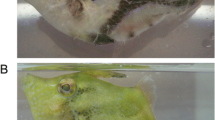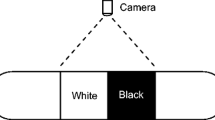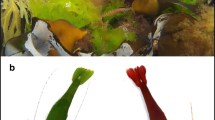Abstract
Cryptic coloration reduces the ability of predators to detect prey, but the plasticity of this defense varies. Some organisms possess static and permanent cryptic coloration, whereas in other species color changes may be induced. Depending upon the species, induced color changes may be reversible or irreversible. In this study, we examined a subtle, rapid, and reversible crypsis in which small fish exhibit muted changes in brightness to match varying substrates in clear spring water. In the laboratory, we visually measured the changes in brightness, using a ten-point brightness scale, of five abundant small species in our study spring. Two species, Lucania goodei and Heterandria formosa, exhibited no change, but the other three species exhibited changes in brightness to match background brightness. Two species, Gambusia holbrooki and Poecilia latipinna, exhibited only slight shifts, whereas Lucania parva exhibited relatively large shifts in brightness and color pattern—from virtually white to tan interspersed with dark-brown bands. In the field, L. parva also exhibited significant shifts in brightness and color pattern, both when swimming freely and when enclosed in an open-bottomed cage. These results suggest that rapid cryptic changes in brightness may augment other forms of defense in small vulnerable fish.





Similar content being viewed by others

References
Armbruster JW, Page LM (1996) Convergence of a cryptic saddle pattern in benthic freshwater fishes. Environ Biol Fish 45:249–257
Barbosa A, Mäthger LM, Chubb C, Florio C, Chiao C, Hanlon RT (2007) Disruptive coloration in cuttlefish: a visual perception mechanism that regulates ontogenetic adjustment of skin patterning. J Exp Biol 210:1139–1147
Beeching SC (1995) Colour pattern and inhibition of aggression in the cichlid fish Astronotus ocellatus. J Fish Biol 47:50–58
Bray AWL (1918) The reactions of the melanophores of Amiurus to light and to adrenalin. Proc Natl Acad Sci USA 3:58–60
Brodie E (1992) Correlational selection for color pattern and antipredator behavior in the garter snake Thamnophis ordinoides. Evolution 46:1284–1298
Brown FA Jr (1936) Light intensity and melanophore response in the minnow, Ericymba buccata Cope. Biol Bull 70:8–15
Chiao C, Hanlon RT (2001) Cuttlefish camouflage: visual perception of size, contrast and number of white squares on artificial checkerboard substrata initiates disruptive coloration. J Exp Biol 204:2119–2125
Cross J, Rush V, Storfer A (1999) Adaptive coloration and gene flow as a constraint to local adaptation in the streamside salamander, Ambystoma barbouri. Evolution 53:889–898
Donnelly WA, Dill LM (1984) Evidence for crypsis in coho salmon, Oncorhynchus kisutch (Walbaum), parr: substrate colour preference and achromatic reflectance. J Fish Biol 25:183–195
Donnelly WA, Whoriskey FG Jr (1991) Background-color acclimation of brook trout for crypsis reduces risk of predation by hooded mergansers Lophodytes cucullatus. NA J Fish Manage 11:206–211
Endler JA (1990) On the measurement and classification of colour in studies of animal colour patterns. Biol J Linn Soc 41(4):315–352
Fairchild EA, Howell WH (2004) Factors affecting the post-release survival of cultured juvenile Pseudopleuronectes americanus. J Fish Biol 65:69–87
Fanouraki E, Laitinen JT, Divanach P, Pavlidis M (2007) Endocrine regulation of skin blanching in red porgy, Pagrus pagrus. Ann Zool Fenn 44:241–248
Fries EFB (1942) Notes on color change and pigmentary innervation in a goby, a wrasse, and the plaice. Biol Bull 82:273–283
Fujii R (2000) The regulation of motile activity in fish chromatophores. Pigment Cell Res 13:300–319
Fuller R (2002) Lighting environment predicts the relative abundance of male color morphs in bluefin killifish (Lucania goodei) populations. Proc R Soc Lond B 269:1457–1469
Fuller RC, Travis J (2004) Genetics, lighting environment, and heritable responses to lighting environment affect male color morph expression in bluefin killifish, Lucania goodei. Evolution 58:1086–1098
Graf B, Nentwig W (2001) Ontogenetic change in coloration and web-building behavior in the tropical spider Eriophora fuliginea (Araneae, Araneidae). J Arachnol 29:104–110
Hanlon RT, Forsythe JW, Joneschild DE (1999) Crypsis, conspicuousness, mimicry and polyphenism as antipredator defences of foraging octopuses on Indo-Pacific coral reefs, with a method of quantifying crypsis from video tapes. Biol J Linn Soc 66:1–22
Hill AV, Parkinson JL, Solandt DY (1935) Photo-electric records of the colour change in Fundulus heteroclitus. J Exp Biol 12:379–399
Hoar WS (1955) Phototactic and pigmentary responses of sockeye salmon smolts following injury to the pineal organ. J Fish Res Bd Can 12:178–185
Johnson S, Sosik HM (2003) Cryptic coloration and mirrored sides as camouflage strategies in near-surface pelagic habitats: implications for foraging and predator avoidance. Limnol Oceanogr 48(3):1277–1288
Kelman EJ, Tiptus P, Osorio D (2006) Juvenile plaice (Pleuronectes platessa) produce camouflage by flexibly combining two separate patterns. J Exp Biol 209:3288–3292
Kiltie RA (1988) Countershading: universally deceptive or deceptively universal. TREE 3:21–23
Manríquez KC, Pardo LM, Wells RJD, Palma AT (2008) Crypsis in Paraxanthus barbiger (Decapoda: Brachyura): mechanisms against visual predators. J Crust Biol 28:473–479
Mäthger LM, Hanlon RT (2006) Anatomical basis for camouflaged polarized light communication in squid. Biol Lett 2:494–496
Matthews SA (1933) Color changes in Fundulus after hypophysectomy. Biol Bull 64:315–320
Merilaita S, Lyytinen A, Mappes J (2001) Selection for cryptic coloration in a visually heterogenous habitat. Proc R Soc Lond B 268:1925–1929
Neill RM (1940) On the existence of two types of chromatic behaviour in teleostean fishes. J Exp Biol 17:74–94
Palma A, Steneck R (2001) Does variable coloration in juvenile marine crabs reduce risk of visual predation? Ecology 82:2961–2967
Parker GH, Porter H (1934) The control of dermal melanophores in elasmobranch fishes. Biol Bull 66:30–37
Pye JD (1964) Nervous control of chromatophores in teleost fishes. IV. A comparative survey of local temperature responses. J Exp Biol 41:553–557
Ramachandran VS, Tyler CW, Gregory RL, Rogers-Ramachandran D, Duensing S, Pillsbury C, Ramachandran C (1996) Rapid adaptive camouflage in tropical flounders. Nature 379:6568
Ruxton GD, Sheratt TN, Speed MP (2004a) Avoiding attack: the evolutionary ecology of crypsis, warning signals and mimicry. Oxford University Press, New York
Ruxton GD, Speed MP, Kelly DJ (2004b) What, if anything, is the adaptive function of countershading? Anim Behav 68:445–451
Sazima I, Carvalho LN, Mendonça FP, Zuanon J (2006) Fallen leaves on the waterbed: diurnal camouflage of three night-active fish species in an Amazon streamlet. Neotr Ichth 4:119–122
Seehausen O, Mayhew PJ, van Alphen JJM (1999) Evolution of color patterns in East African cichlids. J Evol Biol 12:514–534
Stevens M, Yule DH, Ruxton GD (2008) Dazzle coloration and prey movement. Proc R Soc B 275:2639–2643
Sumner FB (1934) Does “protective coloration” protect?—results of some experiments with fishes and birds. Proc Natl Acad Sci USA 20:559–564
Sumner FB (1935) Studies of protective color change. 3. Experiments with fishes both as predators and prey. Proc Natl Acad Sci USA 21:345–353
Sumner FB (1940) Quantitative changes in pigmentation, resulting from visual stimuli in fishes and amphibia. Biol Rev 15:351–375
Thayer GH (1909) Concealing coloration in the animal kingdom. An exposition of the laws of disguise through color and pattern. Macmillan, London
von Frisch K (1911) Beiträge zur physiologie der pigmentzellen in der fischhaut. Arch Physiol 138:319–387
Wente WH, Phillips JB (2003) Fixed green and brown color morphs and a novel color-changing morph of the Pacific Tree Frog Hyla regilla. Am Nat 162:461–473
Wykes U (1936) The photic control of pigmentary responses in teleost fishes. J Exp Biol 15:363–370
Zar JH (1984) Biostatistical analysis, 2nd edn. Prentice-Hall, Englewood Cliffs
Acknowledgments
We thank the Blue Spring State Park, Volusia County, Florida, and the Florida Department of Environmental Protection for their logistical support. We also thank Kelly Jacobi for work on the methodology of the laboratory experiments and Peter May for editing the manuscript. This research was funded in part by a Summer Undergraduate Research Experience (SURE) grant at Stetson University.
Author information
Authors and Affiliations
Corresponding author
About this article
Cite this article
Cox, S., Chandler, S., Barron, C. et al. Benthic fish exhibit more plastic crypsis than non-benthic species in a freshwater spring. J Ethol 27, 497–505 (2009). https://doi.org/10.1007/s10164-008-0148-2
Received:
Accepted:
Published:
Issue Date:
DOI: https://doi.org/10.1007/s10164-008-0148-2



